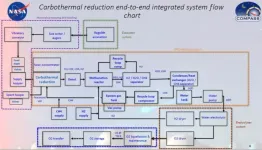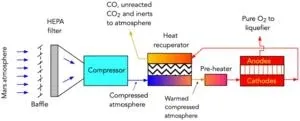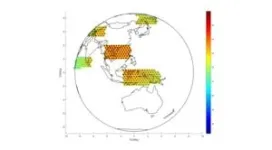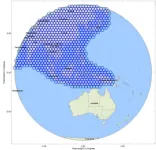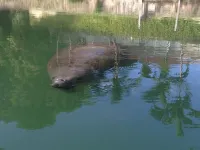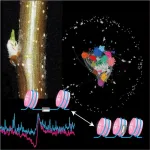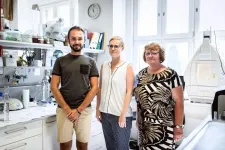Near-term NASA Mars and lunar in situ propellant production: complexity versus simplicity
2024-08-21
(Press-News.org) First, lunar ISPP is analyzed from aspects of lunar resources, near-term lunar processes, carbothermal process, polar ice, and reduction of iron oxides. There are basically 4 potential lunar resources: (1) Silicates in regolith containing typically >40% oxygen. (2) Regolith containing FeO for hydrogen reduction. FeO content may vary from 5% to 14%, leading to recoverable oxygen content in the 1 to 3% range. (3) Imbedded atoms in regolith from solar wind (typically parts per million). (4) Water ice in regolith pores in permanently shadowed craters near the poles (unknown percentage but possibly a few percent in some locations). NASA near-term plans for lunar ISPP appear to be based on H2 and O2 propellants. The carbothermal process (see Fig. 1) produces oxygen from lunar regolith. The plan is to have 2 ISPP modules, each operating independently in batch mode during a 7.4-month continuous sunlit period. The original plan called for each module to produce 8 tons of O2 per year, but a scaled-down version to produce 3.5 tons per year was provided instead. As for polar ice, the author imagines a system in which the excavator/hauler make 1200 trips, delivering 416 kg of water-laden regolith per trip, while the regolith processing station tankers make 37 trips, delivering 275 kg of water per trip. However, it should be noted that nobody has a reliable estimate based on in situ observation. The hydrogen reduction system operates by reducing metal oxides, mainly iron oxide, within the lunar regolith. However, Initial modeling exercises for predicting the overall system mass and power requirements for various oxygen production mass rates using hydrogen reduction which are developed by NASA yield impressively large figures.
Fig. 1. Flowchart for carbothermal process.
Then, Mars ISPP is analyzed from aspects of Mars resources, electrolysis of atmospheric CO2, reverse water gas synthesis (RWGS), and water-based Mars ISPP. Mars resources for ISPP include (a) the atmosphere containing ~95% CO2 as an oxygen supply, (b) regolith containing minerals with water of hydration as a source of H2O, and (c) water ice embedded in near-surface regolith at higher latitudes. The simplest and most straightforward approach to ISPP is electrolyzing CO2 in the Mars atmosphere, splitting CO2 into CO and O2. The system is shown in Fig. 5. It seems likely that NASA could leverage the field of solid oxide electrolysis cell (SOEC) technology with a relatively small investment, by continuing to adapt advances in terrestrial SOEC technology to space applications. As for RWGS, the efficiency is highly influenced by reaction temperature. It remains to be seen how efficient and practical this system will be when further developed. At last, argue that a water-based Mars ISPP is preferred rather than a process produces both CH4 and O2, because for the near term with a minimum of complexity, bringing CH4 to Mars is simpler than carrying water.
Fig. 5. The end-to-end CO2 electrolysis system.
Finally, power for lunar and Martian ISPPs are discussed. Every form of ISPP is power hungry. Providing power for ISPP on the Moon or Mars is a major challenge. The power requirement for ISPP on Mars is roughly comparable to the power requirement for life support after the crew arrives. Thus, the mass, cost, and logistics of the power system is not attributable to ISPP. By contrast, the power requirements for lunar ISPP far exceed the power requirements for life support, and furthermore, the power dissipated in lunar ISPP is additive to power for life support, so the entire mass, cost, and logistics for lunar ISPP power is attributable to lunar ISPP, reducing the ROI. For Mars ISPP, recent studies concluded that use of solar power might be more feasible than previously thought. Compared to nuclear power, solar power might offer mass advantages. Nevertheless, a plan for use of multiple kilopower reactors appears less risky to us. In addition, recent research on Li-CO2 batteries shows promise, and CO2 is readily available on Mars. But this does not appear to be near term. Power on the Moon can be derived from nuclear reactors or solar. Current thinking for lunar ISPP seems to be that solar concentrators would be constructed on a crater ridge and beamed down to a receiver within the permanently shadowed regions of the crater where the concentrated solar flux would be partly converted to electric power. A simpler approach might be a kilopower fission reactor and a tether with a copper wire to the water processing unit. An alternative approach is to beam power down from a satellite array. All in all, the author comes to the conclusion that despite the ongoing mission to return to the Moon, NASA might be best off bringing propellants to the Moon from Earth, while pursuing far more feasible Mars ISPP at a moderate level.
END
ELSE PRESS RELEASES FROM THIS DATE:
2024-08-21
First, the payload requirements and problems faced by traditional multi-beam antenna are described. The user beam of the VHTS payload system mainly uses Ka-band multi-beam antenna for a large range of area coverage, and the number of beams in the coverage area is not less than 500, usually using 7-color frequency reuse scheme(Fig. 2). At present, the spaceborne multi-beam antenna technology applied to high-throughput communication satellites is usually divided into multi-aperture multi-beam antenna and passive multi-feed ...
2024-08-21
Contact NEJM Group Media Relations (mediarelations@nejm.org) if you’d like to receive full-text articles and author contact information for the articles listed below.
Embargoed Until 9 AM ET on Wednesday, August 21
The African American Transplant Access Program: Mitigating Disparities in Solid Organ Transplantation
D. Simpson
The Journey to an Incentive-Based Health Equity Quality Index (Embargo lifted August 14)
E. Cheng
A Physician-Created Platform to Speed Clinical Decision-Making and Referral Workflow
E. Cunningham
How a Robust Community ...
2024-08-21
WASHINGTON—The Endocrine Society today announced it has chosen 14 leading endocrinologists as winners of its prestigious 2025 Laureate Awards, the top honors in the field.
Endocrinologists are scientists and medical doctors who specialize in unraveling the mysteries of hormone disorders to care for patients and cure diseases. These professionals have achieved breakthroughs in scientific discoveries and clinical care benefiting people with hundreds of conditions, including diabetes, thyroid disorders, ...
2024-08-21
The United States National Science Foundation (NSF) and the Paul G. Allen Family Foundation have announced a $1.3 million collaborative grant to the College of Engineering and Computer Science at Florida Atlantic University, Mote Marine Laboratory & Aquarium, and Old Dominion University, for a project designed to cost-effectively identify and track wildlife using artificial intelligence.
Xingquan “Hill” Zhu, Ph.D., principal investigator and a professor in the FAU Department of Electrical Engineering and Computer Science, is spearheading the project in collaboration with FAU’s Harbor Branch Oceanographic Institute and Charles ...
2024-08-21
Individuals with diabetes and obesity may have nutritional deficiencies that go undiagnosed and untreated, which can impact overall health
Providing health care professionals with nutrition tools is key to supporting patient care
Abbott’s grant to the American Diabetes Association will fund evidence generation on the nutritional needs and impact of nutrition formulas on people with diabetes and those living with obesity
ARLINGTON, Va. and ABBOTT, Ill., August 20, 2024 — The American Diabetes Association® (ADA) and Abbott recently announced a collaboration to better understand the nutritional needs of people ...
2024-08-21
The idea of electrically stimulating a brain region called the central thalamus has gained traction among researchers and clinicians because it can help arouse subjects from unconscious states induced by traumatic brain injury or anesthesia, and can boost cognition and performance in awake animals. But the method, called CT-DBS, can have a side effect: seizures. A new study by researchers at MIT and Massachusetts General Hospital (MGH) who were testing the method in awake mice, quantifies the probability of seizures at different stimulation currents and cautions that they sometimes occurred even at low ...
2024-08-21
The integration of machine learning (ML) and automation in laboratory medicine marks a significant advancement, revolutionizing diagnostic accuracy and operational efficiency. This review examines the impact of these technologies, highlighting both their potential benefits and the challenges they pose. The advent of automation combined with ML has introduced new capabilities in pattern detection, predictive analytics, and sophisticated data handling, which are crucial for navigating the complexities of biomedical data. However, these advancements also bring concerns regarding data privacy, the need for stringent validation procedures, and the integration of new technologies into existing ...
2024-08-21
Evolution has enabled plants to survive under adverse conditions. The winter bud of a plant is a crucial structure that establishes adaptability. Depending on environmental and intrinsic conditions, buds can transition between growth and dormancy. The three dormancy phases are determined by signals triggering each phase: ecodormancy, influenced by environmental factors; paradormancy, promoted by other plant organs; and endodormancy, maintained by internal signals within the bud. Paradormant buds enter endodormancy in response to changes in day length and/or low temperature in autumn, while endo-and eco-dormant phases occur ...
2024-08-21
Scientists on the team of Dr Lenka Maletínská have developed a promising new compound derived from one of the peptides naturally occurring in the brain. Its application may contribute to the addressing of two major health challenges of the modern days: obesity and Alzheimer's disease. The neuropeptide CART is primarily associated with the regulation of food intake. Its modified version, created at the Institute of Organic Chemistry and Biochemistry of the Czech Academy of Sciences, shows better stability and is more effective. It suppresses appetite and protects the brain by reducing the pathogenicity of the tau protein, which is associated with ...
2024-08-21
The innovative strength of a society depends on the level of academic freedom. An international team involving the Technical University of Munich (TUM) has now proven this relationship for the first time. The researchers analyzed patent applications and patent citations in a sample from around 160 countries over the 1900–2015 period in relation to indicators used in the Academic Freedom Index. In view of the global decline in academic freedom over the past 10 years, the researchers predict a loss ...
LAST 30 PRESS RELEASES:
[Press-News.org] Near-term NASA Mars and lunar in situ propellant production: complexity versus simplicity
